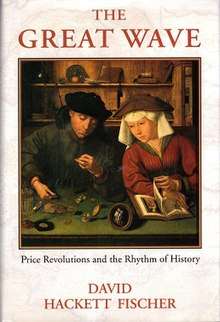The Great Wave (book)
The Great Wave: Price Revolutions and the Rhythm of History is a scholarly work by historian David Hackett Fischer, published 1996 by OUP. Hackett Fischer identified three complete monetary waves in European history, each consisting of; a), price revolution, featuring high inflation, followed by; b) a war crisis, followed by; c) equilibrium.[1]

A fourth wave began, says Fischer, with the persistent monetary inflation of the 20th century.[2]
First wave
Fischer says this began with the medieval price revolution, 1180-1350. There followed crisis in the 14th and 15th centuries, featuring the Black Death and Hundred years war. Then equilibrium during the early Renaissance, 1400-1470 [3]
Second wave
This began with the ‘price revolution of the 16th century’, in fact lasting from about 1470-1590.[4] Crisis followed; depression, famine, the Thirty Years' War (1618–1648), English Civil War, Dutch Revolt and other conflicts.[5]
According to Fischer the Enlightenment equilibrium which followed lasted from 1660-1730.[6]
Third wave
The price revolution of the 18th century [7] began about 1729, says Fischer. Commodity prices rose in England (sic), France and the United States (sic!).[8] large population increases occurred in most of Europe.[9] Wage rates failed to keep pace with grain price rises, and wealth inequality increased.[10] A rising spirit of rebellion led to a ‘revolutionary crisis’, 1789-1820.[11] The French revolution was followed by the Napoleonic wars and Latin American wars of independence. Stability was regained in the ‘Victorian equilibrium’, 1820-96. Consumer prices fell in England (sic).[12] There were revolutions in transportation, agriculture, industry and commerce [13] But by the end of this era, young Englishmen were ‘bankrupt, bored and bloody-minded… the dark clouds began to gather.’ [14]
Fourth wave
Fischer identifies a further ‘price revolution’ in the 20th century, by which time there were no new lands left to explore or colonise. The German hyperinflation of 1923 and the Great depression of 1929 were followed by accelerating worldwide inflation after 1962.[15] Though inflation had ended by 1996,[16] Fischer speculated (1996) that ‘the great wave of the 20th century (approaches) its climax’ and that ‘A major war in the Middle East or eastern Europe or elsewhere could reignite inflation.’ [17]
Conclusions
Fischer observed that these movements were not cycles but waves, with no fixed periodicity. Each wave had six common features. Chronologically, these were; 1), prolonged prosperity, 2) political disorder, 3) inflation spiral, 4) spiritual crisis, 5) revolution, deflation, 6) long era of equilibrium.[18]
Limitations of the theory
Fischer predicted (1996) that ‘the price revolution of the 20th century has yet to reach its climax’.[19] But as of 2017, the implied crisis he predicts has yet to happen; recent works by Steven Pinker [20] and Joshua S Goldstein [21] suggest that war and violence are decreasing.
Paul Krugman [22] offers the comment that 'most big-think books about history offer only strained analogies mixed with pretentious statements of the obvious.' Thomas J Archdeacon [23] calls the theory 'vivid', 'shrewd' and 'strongly persuasive', but suspects it is 'blood in the water for academic sharks hunting outsiders venturing into their territory.' The argument that the world is heading for a crisis 'has the vagueness of analogy.'
In a long and detailed review, John H Munro of Toronto university [24] deplores the absence of mathematical modeling; the theory is 'rather too neat' for him to accept.
Finally, the book has a Eurocentric or western bias, with no data at all about the significant Asian economies.[25]
See also
References
- David Hackett Fischer, The Great Wave, OUP 1996, p 4
- Fischer, p. 182 et seq.
- Fischer, pp. 36-60.
- ibid p. 91.
- David Hackett Fischer, The Great Wave, OUP 1996, p98-9
- David Hackett Fischer, The Great Wave, OUP 1996, p102 et seq
- David Hackett Fischer, The Great Wave, OUP 1996 p 117
- David Hackett Fischer, The Great Wave, OUP 1996 p 120
- David Hackett Fischer, The Great Wave, OUP 1996 p 124
- David Hackett Fischer, The Great Wave, OUP 1996 p 138
- David Hackett Fischer, The Great Wave, OUP 1996 p 141-2
- David Hackett Fischer, The Great Wave, OUP 1996 p158
- David Hackett Fischer, The Great Wave, OUP 1996, p 168
- David Hackett Fischer, The Great Wave, OUP 1996, p164
- David Hackett Fischer, The Great Wave, OUP 1996 p 203
- ibid p233
- David Hackett Fischer, The Great Wave, OUP 1996 p 234
- David Hackett Fischer, The Great Wave, OUP 1996, p237-8
- David Hackett Fischer, The Great Wave, OUP 1996, p240
- The better angels of our nature, 2011, chapters 2-7
- Joshua S Goldstein and Steven Pinker, 'war really is going out of style, New York Times, 17/12/2011
- Book Review, Foreign Affairs, July/Aug 1997
- Book Review, New York Times, Jan 1997
- EH.Net, Feb 1999
- Andre Gunder Frank and Robert Denemark, Reorienting the 19th century, Routledge, 2015, p 45